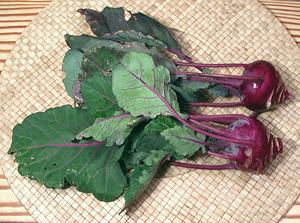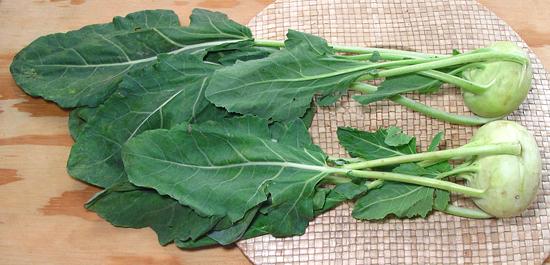 Kohlrabi aren't necessarily green, but you won't find purple ones in your
local supermarket, only in the more adventurous farmer's markets. The
interior of the purple stem is pale, like the green kohlrabi.
Kohlrabi aren't necessarily green, but you won't find purple ones in your
local supermarket, only in the more adventurous farmer's markets. The
interior of the purple stem is pale, like the green kohlrabi. [Su Hao (Viet); Ganth Gobhi (Hindi); Knol-Khol (Tamil); Monj-hakh,
Haakh (Punjab); B. oleracea group Gongylodes]
[Su Hao (Viet); Ganth Gobhi (Hindi); Knol-Khol (Tamil); Monj-hakh,
Haakh (Punjab); B. oleracea group Gongylodes]
Like head cabbage, broccoli, cauliflower, kale, collard greens, and Brussels sprouts, Kohlrabi was created from wild cabbage by human selection. It may look like it belongs with the root cabbages but the "bulb" is actually a swollen stem so it's all "greens", and is similar to broccoli stem, but sweeter and easier to work with.
Generally, Kohlrabi are eaten fairly small because they become woody as they grow larger, but one cultivar, Gigante, is still edible in larger sizes. Kohlrabi are usually marketed at about 2 inches in the spring and 4 inches in the fall. Young kohlrabi can be eaten raw in salads as well as being cooked.
More on Cabbage Greens.
 Kohlrabi aren't necessarily green, but you won't find purple ones in your
local supermarket, only in the more adventurous farmer's markets. The
interior of the purple stem is pale, like the green kohlrabi.
Kohlrabi aren't necessarily green, but you won't find purple ones in your
local supermarket, only in the more adventurous farmer's markets. The
interior of the purple stem is pale, like the green kohlrabi.
While developed in Europe, and usually associated with northern Europe, kohlrabi is well known in temperate zones from Pakistan through China. It is an important vegetable in Kashmir, where they also grow a version without a swollen stem, just leaves, called Haakh. The bulb version is called Monj-haakh. As Knol Khol and Ganth Gobhi it is popular in other parts India, mostly in the north. In some parts of China it is called "Jade Turnip".
Kolrabi leaves are quite edible and nutritious, but they are tough, much like Collard Greens, and need to be simmered at least 45 minutes to be tender. Leaf stems will still be crunchy and a bit fibrous with that length of cooking.